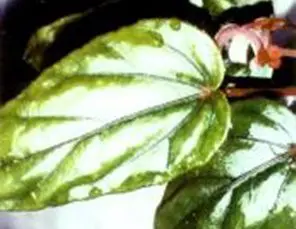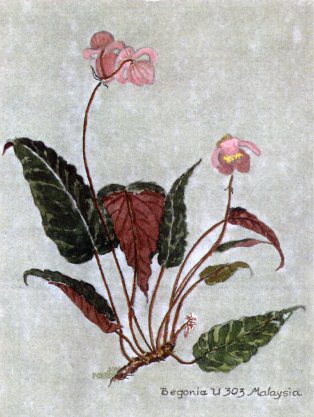At the 1993 Convention in Miami, Tamsin Boardman gave a leaf of a plant labeled B.U303 to Barbara Nunes. Barbara gave it to me for propagation. The only information available about the plant was that Scott Hoover collected it in Malaysia. Since then, I have talked to Scott at a convention, but, without his collection notes, he could only remember that it grew in a soil consisting of volcanic dust and humus. When I saw Freda’s request for information about B.U303 in the November/December 2001 Begonian, Idecided to pass along what information I have obtained from growing it for several years.
B. U303 has a creeping habit. The stem is 0.3 cm. to 0.5 cm. in diameter. Older stems are light green, sometimes flushed light cranberry between the nodes with short fine hairs and with very small white pustular areas scattered along the length of the stem. Newer growth is cranberry in color with longer hairs. Recently the stems, after creeping over and rooting in the medium for 2 cm. to 6 cm., have started growing upwards. This upward growth is new for my plants, but may be occurring because of crowding in the terrarium and the use of overhead lighting. The stipules are very persistent – even in the humidity of the terrarium. They are cranberry in color, drying to brown. The stipules are roughly triangular in shape with the average size measuring.6 cm. x.4 cm. Each stipule has a single or double bristle at the tip.
Right is Mary Bucholtz’ photo showing a flower
Petioles are variable in length. Most mature petioles are 6.5 cm. to 17 cm. There is a groove that runs the length of the petiole on the side that corresponds with the upper side of the leaf. This groove appears to align with the center vein at the point where the petiole attaches to the leaf blade. On some petioles there are two shallow grooves, one on each side of and running parallel to the deeper center groove. The petioles are covered with sparse fine white hairs that become longer and coarser at the leaf base. The petioles are light cranberry in color. Mature leaf blades are roughly shaped like an elongated triangle, 10 cm. to 12 cm. long, and 4.5 cm. to 5 cm. wide at the base. The front of the leaf blade is medium green with an olive green undertone. The larger veins are cranberry in color and raised; the smaller veins are green and even with the surface or slightly depressed. There is a slight puckering of the leaf between the veins. On the leaf surface there are scattered sparse very short fine beige hairs over the leaf surface with occasional short (.1 cm. or less) coarse white hairs. The backs of the leaves are light cranberry to medium green with raised cranberry veins covered with a moderate amount of short white coarse hairs. Leaf bases are cordate or unevenly cordate; leaf apices are generally acute, but occasionally acuminate. The leaf edge is serrulate.
Unfortunately, my plant is not flowering so I cannot describe the blooms. Blooms on my plant have been sparse and pink, with male and female blooms appearing at the same time. The plant has not bloomed every year nor does it appear to have a particular season for blooming. For those of us who grow B. 0303 in Virginia, it must be grown in a terrarium.
One small plant survived on our kitchen windowsill for a few weeks, so perhaps it could grow without a terrarium in a humid greenhouse or climate. I grow it under regular florescent lights (one cool white, one warm white) on a stand in our basement, or in a north-facing window. The potting medium is cut long fibered sphagnum moss over horticultural charcoal, over perlite. I occasionally fertilize using one-eighth strength fertilizer in warm water misted over the foliage and medium. For the past four years it has filled a shallow 14″ terrarium. Several years ago, one of our branch members brought in a B. U303 grown in a terrarium in a light soil mix and fed frequently. The leaves were one third larger, darker, and thicker. I have moved my terrarium to a light stand with more light and will fertilize it more regularly to try to encourage it to bloom.
Above: Johanna Zinn’s photo of her terrarium grown B.U303
If any of you are growing B. U303, please send any information you have about it to Thelma O’Reilly. If anyone is interested in growing this plant, please look for it on the sale tables in Houston this May.




